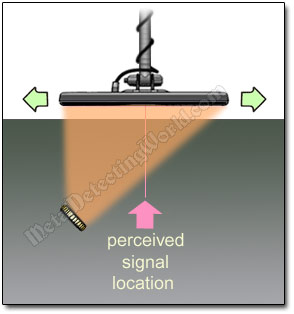Search Coils for Metal Detectors, page 15
Pinpoint Metal Detected Targets: Angled Coin and Secondary Electromagnetic Field Generated by It
(...CONTINUED from previous page)
Pinpointing Angled Coins
A coin that rests on an angle presents one of the most difficult obstacles to accurate pinpointing because the orientation of a buried coin affects your ability to accurately pinpoint its location with respect to the search coil's center point. For example, a coin on a 45 degree angle will generate a secondary electromagnetic field on angle rather than directly upward like a coin lying flat or parallel to the search coil bottom.
Secondary Electromagnetic Field Generated by Coin on 45 Degree Angle

Even though you think the signal is physically aligned with the search coil's center point, the target will be to the side. The greater the angle of the coin with respect to the bottom of the search coil, the greater the error can be expected in pinpointing.
Unfortunately coins on an angle less than 90 degree to the search coil will not usually give any special audio signal to set them apart from coins lying flat. This accounts for the reason many coins are scratched during recovery.
If you are coin shooting on a manicured lawn, and you have to keep the recovery areas small and neat, the best way to determine if the coin is lying on an angle is to use a probe (a screwdriver with dull tip). If you metal detect in the wooded area or at the farm field, cut larger dirt plugs to avoid hitting the off-center coins with your shovel blade.